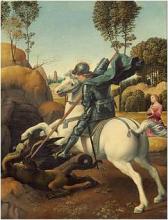St George's Day, April 23rd - Patron Saint of England
Who was he? According to legend, St George was a Roman soldier born in what is now modern-day Turkey in around 280AD and died around 303. Very little is known about his early life, but it is believed he was born to a wealthy Christian noble family. When he grew up he became a soldier and joined the retinue of Emperor Diocletian.
In 303 Diocletian, as part of a crackdown on the growing influence of the Christian community, ordered that all Christian soldiers in the army should be expelled and all Roman soldiers be forced to make the traditional pagan sacrifice. St George refused and denounced the edict in front of his fellow soldiers, declaring he was a Christian. Diocletian initially tried to convert him with offers of wealth and land but when he refused he was beheaded on 23 April 303.
So what does he have to do with dragons? The myth of St George slaying a dragon originally appeared in stories told by the medieval Eastern Orthodox Church which were brought back to Europe by the Crusaders in the 10th and 11th centuries. According to one story, a town in Libya had a small lake with a plague-infected dragon living in it. The townspeople were gradually being killed by the dragon and started feeding it two sheep a day to appease it. When they ran out of sheep the king devised a lottery system to feed it local children. One day his own daughter was chosen and as she was being led out to the lake St George happened to ride past. He reportedly offered to slay the dragon if the people converted to Christianity. They all did, and the king later built a church where the dragon died.
If he was from Turkey how did he become the patron saint of England? King Edward III made St George the country's official saint just after he came to the throne in 1327, replacing St Edward the Confessor.
Webmaster
